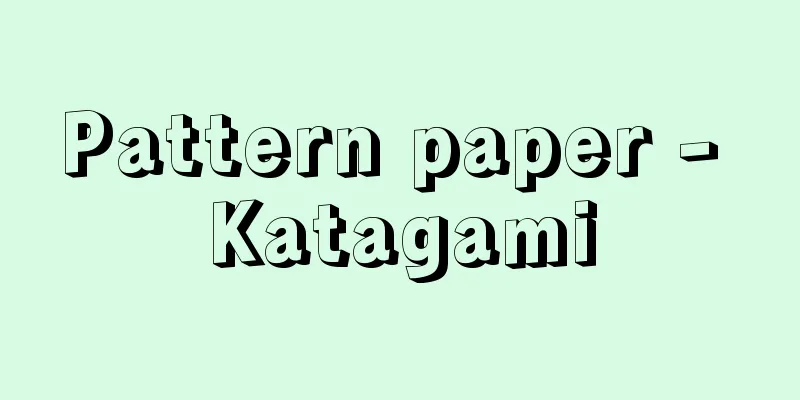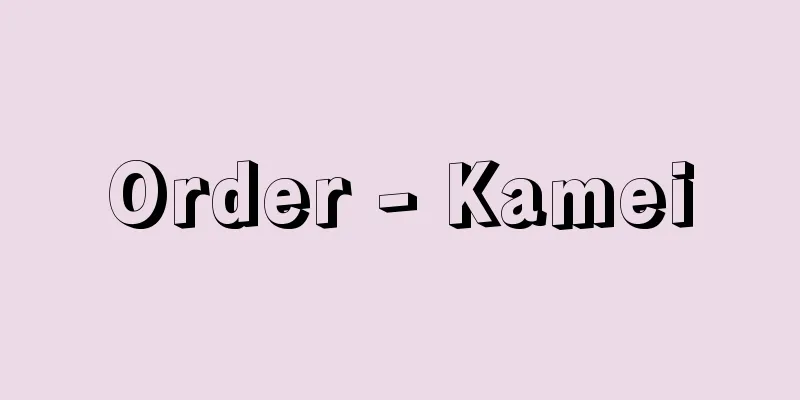Pattern paper - Katagami

|
Paper cut into a shape is also called a pattern. It is used in dyeing, dressmaking, handicrafts, etc. [Nobuhiko Sugihara] Dyeing stencilsIts origins date back to ancient times, when it was used to dye the leather of stirrups, which was popular from the end of the Heian period to the Kamakura period. It was later used to dye fabric, and in Japan the technique of stencil dyeing, in which a stencil is used to apply a dye-resistant paste and dye the pattern, has shown unique development and continues to this day. The oldest surviving examples date back to the Genroku period (1688-1704), and examples that are thought to have used it include small-patterned kimonos from the end of the Muromachi period. The paper on which the stencils are carved is called katajigami, or simply jigami. To prevent distortion of the stencil, high-quality Japanese paper, pure kozo paper, is used for the jigami, and 2-3 sheets are pasted together with persimmon tannin so that the fibers overlap vertically and horizontally. The process of cutting the paper according to the papermaking dimensions so that it fits onto the jigami without waste is called "hozokuru." The tenoned paper is pasted onto a "tsukeita" (attaching board) that is propped up at an angle, and then layered with persimmon tannin using a straw brush. After pasting one sheet of jigami, the bottom left corner is folded and pasted on top of the next. The total thickness is about 0.9 centimeters, and the equivalent of about 40 sheets of jigami are pasted on top of each other, and the folded parts are removed with a nail and pasted onto a drying board to dry in the sun. The base paper is dried in the sun, and there are two types: one that is dried naturally over several years, and one that is dried in a room and smoked to quickly dry out the tannins, called "murogarasi." The murogarasi type includes "nidomuro," which is dried once, smoked again, and then dried again. This method of drying was invented by Kitamura Jihee around 1877 (Meiji 10), and produces a hard base paper, but it is fragile, so naturally dried paper is better for carving intricate designs. The stencil is called "hitohori" and is usually carved by layering 7 to 8 sheets of base paper. For picture-like patterns, the sketch itself may be pasted onto the upper mold and carved, or the sketch may be copied onto the upper mold using carbon paper. For split patterns or detailed continuous designs, a small stencil called a "kohon" is carved, which is then rubbed into the required area and carved out. For split patterns and other intricate designs that require precision, a method called "sokei" is used, in which the blade of a knife is lightly crushed to create a ruling, and then finely drawn ruling lines are carved across the entire surface. There are various techniques for carving patterns, depending on the design to be carved, including kiribori (drill carving), hikibori (draw carving), tsukibori (thrust carving), dogubori (tool carving), and itaitsuki (one-piece carving), which is a type of dogubori, as well as auxiliary techniques such as "thread insertion" and "shabari (gauze pasting)" to reinforce the shape. (1) Tsui-bori: A crescent-shaped tsui-bori (drill) is used to carve round holes by rotating it half a turn, and these small circular patterns are used to create the design. Famous patterns include the shark pattern and the through pattern. (2) Hikibori: This is called hikibori because the knife is pulled toward the user to carve. Lines and generally pictorial patterns are carved. (3) Tsutsubori: The tip of a sharp blade is placed against the hand, thrust into the wood at a right angle, and the blade is moved up and down as the carving progresses. This is suitable for carving intricate designs by layering the work. Even old striped patterns are carved using the tsutsubori method. (4) Tool carving: The tip of the blade is shaped like a triangle or square, or a single unit of a pattern. With one push of this tool, a triangle or square hole is made. Famous patterns include checkered patterns and Nabeshima komon patterns. (5) One-piece cutting: A single blade with a straight or arced tip, which can be carved into a straight or arced shape with a single push. For example, a straight line can be carved into a square by pushing it four times. This allows the corners of the pattern to be carved sharper than with tool carving, and the pattern is crisper. (6) Thread insertion: When stripes and other patterns are carved, they are flimsy and unstable, so this method fixes and stabilizes the pattern. To carve a thread insertion mold, the base paper is peeled off into two pieces, a backing paper and a top paper, which are stacked and carved, the backing paper is attached to a frame, a thread insertion frame with thread stretched around it is placed on top of this, and the top paper is pasted on top with persimmon tannin so that there is a thread stretched between the two pieces of paper, and this thread stabilizes the carved pattern. (7) Gauze Paste Stencil Because thread insertion requires advanced skills, this technique was invented around 1921 by Gihee Inami, a dyer from Takaoka, Toyama Prefecture. In order to fix the spaces between the patterns, thin strips of paper are carved into the stencil to form a “hanging” pattern. Newspaper or other paper is pasted on the back of the stencil, and after it dries, the “hanging” pattern is cut off. Gauze is pasted on the surface with lacquer to fix the pattern, and the paper pasted on the back is then removed with water to finish the process. There are stencils that can be used to dye a complete pattern on a single piece of stencil, two-piece stencils in which the same design with intricately detailed designs is carved onto two pieces of stencils, and stencils for Kata-Yuzen that are carved by color and consist of dozens of pieces in a set. [Nobuhiko Sugihara] Dressmaking patternsThey are used when cutting materials, and by sewing the various parts together the desired shape is created. There are two methods: one where the pattern is based on a flat prototype of the upper half of the human body, and the other where it is made by cutting the garment in three dimensions. The former is a versatile method but requires training to use it effectively. In Japan, each dressmaking school develops its own prototypes, and the drawing methods differ, making it difficult to use. The latter is a method often applied to patterns for ready-made clothing, as the finished style is clear and the three-dimensional shape can be accurately flattened. In Europe, books on cutting methods began to appear at the end of the 17th century, but patterns were kept secret by master tailors. Commercially available patterns did not appear until the 19th century, and a method of drawing using measurements and calculations was developed. Initially, patterns were sold to professionals, but from the 1840s, when home dressmaking became popular, they began to be included as fold-out supplements in women's magazines and became widespread. The first pattern companies were established in the United States, with Butterick in 1863 and McCall's in 1870. Their simple patterns made a major contribution to the development of ready-made clothing. [Masumi Tsuji] "Dyeing Stencils" by Nobuhiko Sugihara (1968, Kyoto National Museum) [Reference item] |Source: Shogakukan Encyclopedia Nipponica About Encyclopedia Nipponica Information | Legend |
|
型に切った紙のことでパターンpatternともいう。染色や洋裁や手芸などに使われる。 [杉原信彦] 染色用型紙その起源は古く、平安末期から鎌倉時代に盛行をみた鐙(あぶみ)の染韋(そめかわ)に用いられた。その後布染めに用いられ、わが国では型紙をもって防染糊(のり)を置き、文様を染め出す型染めの技法が特異な発達をみせて今日に至っている。現存のものでは元禄(げんろく)(1688~1704)ごろのものがもっとも古く、これを用いたと思われるものに、室町末期の小紋の帷子(かたびら)などがある。 型紙を彫る用紙のことを型地紙あるいは略して地紙とよんでいる。地紙は型の狂いをなくすため良質の和紙、純粋の楮紙(こうぞがみ)を用い、その繊維が縦横に重なるように2~3枚柿渋(かきしぶ)で貼(は)り合わせる。紙の漉(すき)寸法に従い、むだなく地紙に貼り合わせるように設計裁断することを「ほぞくる」といっている。ほぞくった紙は斜めに立てかけた「つけ板」に藁刷毛(わらばけ)をもって柿渋で貼り重ねられる。地紙1枚分を貼り重ねると左下隅を折り曲げておき、次々と貼り重ねる。その厚みは約0.9センチメートル、地紙約40枚分貼り重ね、折り曲げたところをくぎりにはがし、干し板に貼って天日で乾燥させる。地紙は天日乾燥され、数年かけて自然に渋を枯らしたものと、室(むろ)に入れ燻煙(くんえん)して急速に渋を枯らす「室枯(むろがらし)」のものがあり、室枯には一度室枯したものにさらに渋をし、ふたたび室枯する「二度室(にどむろ)」のものがある。この室枯の方法は1877年(明治10)ごろ北村治兵衛(じへえ)によってくふうされたもので、材質の固い地紙となるがもろく、細緻(さいち)な図柄を彫るには自然枯のものがよい。 型紙は「一彫(ひとほ)り」といって通常7~8枚の地紙を重ねて彫る。絵柄風の模様は、下絵そのものを上型に貼って彫る場合と、下絵を上型にカーボンで写して彫る場合がある。割付け柄や細かな連続文様付けでは、小本といって小さな型紙に彫り、これを必要な面積に摺(す)り込んで展開して彫る場合と、とくに割付け柄などで細緻なもので正確さを要するものは、「総罫(そうけい)」といって、小刀の刃を軽くつぶしたもので罫引きし、彫面全体に細かく割付け線を引いて彫る方法がある。 文様を彫るには、おのおのその彫るべき文様により、錐(きり)彫り、引彫り、突彫り、道具彫り、道具彫りの一種である一枚突きの手法があり、型を補強するための「糸入れ」や「紗貼(しゃば)り」の補助技法がある。 (1)錐彫り 刃先が半月形をした錐様の刃物を用い、これを半回転させて丸い穴を彫りあけ、この小円文によって模様を構成する。著名な柄として鮫(さめ)小紋や通し小紋がある。 (2)引彫り 小刀を手前に引いて彫るので引彫りという。筋や一般に絵画的な模様を彫る。 (3)突彫り 鋭い刃物の刃先を手向こうにし、直角に突き立て、刃物を上下させながら彫り進む。重ね彫りし、細緻な図柄を彫るに適している。縞柄(しまがら)でも古いものは突彫りによっている。 (4)道具彫り 刃先が△や□など文様の一単位をした形をしており、この刃物で一押しすると△や□の穴があく、著名な柄に市松(いちまつ)や鍋島(なべしま)小紋がある。 (5)一枚突き 刃先が直線や弧になった一枚刃で、一押しすることによって直線や弧が彫れる。たとえば直線を4回押すことによって四角を彫る。こうしたことから道具彫りよりも文様の隅が鋭く彫れ、文様の歯切れがよい。 (6)糸入れ 縞柄など彫ったままでは文様部がべらべらして、不安定なので、型を固定し、安定させる方法である。糸入れ型を彫るには地紙を台紙と上紙2枚にはがし、これを重ねて彫り、台紙を貼枠に貼り、糸を張り巡らせた糸入れ枠をこれに重ね、柿渋をもって上紙を貼り重ねて、紙と紙の間に糸が張ってあるようにし、この糸で彫文様を安定させる。 (7)紗貼りの型 糸入れが高度の技術を要するので1921年(大正10)ころ富山県高岡の染工・井波義兵衛(ぎへえ)によってくふうされた手法で、文様と文様の間を固定するために細く連ねた、「吊(つ)り」を彫り出した型紙の裏面に新聞紙などの紙を貼り、乾いたのち「吊り」を切り落とし、表面に漆によって紗を貼って、文様を固定してから、裏面に貼ってある紙を水で除去して仕上げる。 型紙には型紙1枚で完全な模様が染め上がるものと、複雑細緻な図柄で同一文様を2枚の型紙に彫り分けた二枚型のもの、型友禅の型紙のように色ごとに彫り分け何十枚をもって一組とするようなものもある。 [杉原信彦] 洋裁用型紙材料を裁断する際に使用し、各部を縫い合わせれば望みの形にできあがるようになっている。人体の上半身を平面図形化した原型を基準にして製図する方法と、立体裁断してつくる方法がある。前者は応用がきく方法であるが、使いこなすには訓練を要する。わが国では各洋裁学校が独自に原型を開発しており、製図法に差異があって扱いにくいのが難点になっている。後者は既製服の型紙によく応用される方法で、できあがりスタイルが明確で、立体の平面化が正確である。 ヨーロッパでは17世紀末から裁断法の本が現れるが、型紙は仕立屋の親方の秘伝になっていた。市販の型紙が現れたのは19世紀に入ってからで、採寸と計算による製図法も開拓された。当初は専門家向けに販売されたが、家庭洋裁が盛んになった1840年代から婦人雑誌の折り込み付録に扱われるようになり一般化していった。 最初に型紙会社が設立されたのはアメリカで、1863年にバタリック社が、70年にはマッコール社が登場し、平明な型紙は既製服の発展にも大きく寄与した。 [辻ますみ] 『杉原信彦著『染の型紙』(1968・京都国立博物館)』 [参照項目] |出典 小学館 日本大百科全書(ニッポニカ)日本大百科全書(ニッポニカ)について 情報 | 凡例 |
>>: Scale insects - Scale insects
Recommend
Eurydice (Queen of Macedonia) - Eurydice
…However, after the sudden deaths of Philip III, ...
Silica cement
…It is also used as a flooring and wall material....
Sho-nei
Year of death: 19 September 1620 (14 October 1620)...
Toilet soap (English spelling)
This is soap for washing the face and hands, and i...
decoration
… [Patterns as decoration] The objects that are d...
Engi-no-sei-tai (Engi era)
The title of a Heike song. A small secret. Emperor...
FMS - FMS
An automated production system that can handle sma...
Ayudak - Ayudak
...along the southern coast, the Crimean Mountain...
Analcestes - Analcestes
…They are so-called scleractinian phyla, and thei...
Hainan New Journal
...A daily newspaper published in Kochi before Wo...
Zenritsukata - Zenritsukata
An institution established in the Muromachi Shogun...
Germanicus I(J)ulius Caesar
Front 15 - Back 19 Roman politician and soldier. E...
General Terms
This refers to a provision that generally and abst...
Parisii
...Also, the Eurotunnel, which opened in 1994, sh...
Gangi ladder - Gangibashigo
〘noun〙 A ladder made from a single thick piece of ...


![Takasaki [town] - Takasaki](/upload/images/67cc1cea66636.webp)



![Kamimaki [Hot Springs] - Kamimaki](/upload/images/67d01e82aa1cb.webp)


